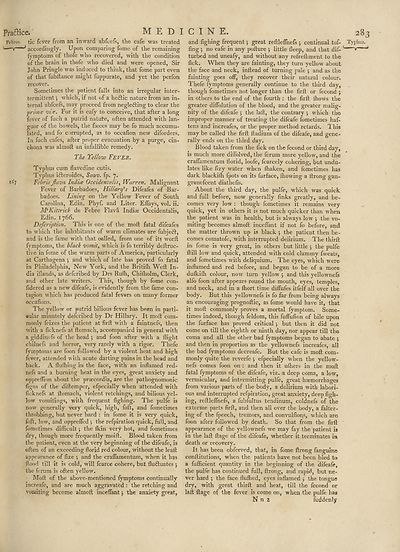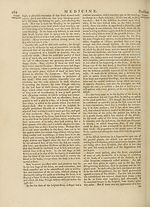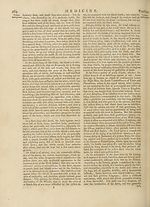Encyclopaedia Britannica, or, a Dictionary of arts, sciences, and miscellaneous literature : enlarged and improved. Illustrated with nearly six hundred engravings > Volume 13, MAT-MIC
(325) Page 283
Download files
Complete book:
Individual page:
Thumbnail gallery: Grid view | List view

Pra&ice. M E D I
Febrcs. tic fever from an inward abfcefs, the cafe was treated
accordingly. Upon comparing fome of the remaining
fymptoms of thofe who recovered, with the condition
of the brain in thofe who died and were opened, Sir
John Pringle was induced to think, that fome part even
of that fubftance might fuppurate, and yet the perfon
recover.
Sometimes the patient falls into an irregular inter-
termittent which, if not of a heftic nature from an in¬
ternal abfcefs, may proceed from negledting to clear the
primce vie. For it is eafy to conceive, that after a long
fever of fuch a putrid natute, often attended with lan¬
guor of the bowels, the faeces may be fo much accumu¬
lated, and fo corrupted, as to occafion new diforders.
In fuch cafes, after proper evacuation by a purge, cin¬
chona was almoft an infallible remedy.
The Yellow FEVER.
Typhus cum flavedine cutis.
Typhus idleroides, Sauv. fp. 7.
167 Febris Jlava Indue Occidentalism Warren. Malignant
Fever of Barbadoes, Hillanfs Difeafes of Bar-
badoes. Lining on the Yellow Fever of South
Carolina, Edin. Phyf. and Liter. Elfays, vol. ii.
AT Kit trick de Febre Flava Indiae Occidentalis,
Edin. 1766.
Dcfcription. This is one of the moft fatal difeafes
to which the inhabitants of warm climates are fubjedf,
and is the fame with that called, from one of its worft
fymptoms, the black vomit, which is fo terribly deftruc-
tive in fome of the w’arm parts of America, particularly
at Carthagena •, and which of late has proved fo fatal
in Philadelphia, New York, and the Britilh Well In¬
dia illands, as defcribed by Drs Rufh, Chilholm, Clerk,
and other late writers. This, though by fome con-
fidered as a new difeafe, is evidently from the fame con¬
tagion which has produced fatal fevers on many former
occafions. \
The yellow or putrid bilious fever has been in parti-
eular minutely defcribed by Dr Hillary. It moft com¬
monly feizes the patient at firft with a faintnefs, then
with a fieknefs at ftomach, accompanied in general with
a giddinefs of the head 5 and foon after with a flight
chilnefs and horror, very rarely with a rigor. Thefe
fymptoms are foon followed by a violent heat and high
fever, attended with acute darting pains in the head and
back. A fluthing in the face, with an inflamed red-
nefs and a burning heat in the eyes, great anxiety and
oppreflion about the praecordia, are the pathognomonic
ftgns of the diftemper, efpecially when attended with
fieknefs at ftomach, violent retchings, and bilious yel¬
low vomitings, with frequent fighing. The pulfe is
now generally very quick, high, foft, and fometimes
throbbing, but never hard : in fome- it is very quick,
foft, low, and oppreffed •, the refpiration quick, full, and
fomctimes difficult j the fkin very hot, and fometimes
dry, though more frequently moift. Blood taken from
the patient, even at the very beginning of the difeafe, is
often of an exceeding florid red colour, without the leaft
appearance of fize *, and the craffamentum, when it has
flood till it is cold, will fcarce cohere, but fluctuates $
the ferum is often yellow.
Moft of the above-mentioned fymptoms continually
increafe, and are much aggravated : the retching and
vomiting become almoft inceffant $ the anxiety great,
CINE.
and fighing frequent; great reftlefTnefs ; continual tof- Typl
fmg 5 no eafe in any pofture 5 little fleep, and that dif- ~v
turbed and uneafy, and without any refreftiment to the
lick. When they are fainting, they turn yellow about
the face and neck, inftead of turning pale ; and as the
fainting goes off, they recover their natural colour.
Thefe fymptoms generally continue to the third day,
though fometimes not longer than the firft or fecond j
in others to the end of the fourth : the firft (hows the
greater diffolution of the blood, and the greater malig¬
nity of the difeafe ; the laft, the contrary ; which the
improper manner of treating the difeafe fometimes haf-
tens and increafes, or the proper method retards. This
may be called the firft ftadium of the difeafe, and gene¬
rally ends on the third day.
Blood taken from the lick on the fecond or third day,
is much more diffolved, the ferum more yellow, and the
craffamentum florid, loofe, fcarcely cohering, but undu¬
lates like fizy water when ftiaken, and fometimes has
dark blackilh fpots on its furface, (bowing a ftrong gan-
grenefeent diathefis.
About the third day, the pulfe, which was quick
and full before, now generally finks greatly, and be¬
comes very low : though fometimes it remains very
quick, yet in others it is not much quicker than when
the patient wras in health, but is always low ; the vo¬
miting becomes almoft incefl'ant if not fo before, and
the matter thrown up is black *, the patient then be¬
comes comatofe, with interrupted delirium. The third
in fome is very great, in others but little 5 the pulfe
ftill low and quick, attended with cold clammy fweats,
and fometimes with deliquium. The eyes, which wrere
inflamed and red before, and began to be of a more
dufkifti colour, now turn yellow ; and this yellownefs
alfo foon after appears round the mouth, eyes, temples,
and neck, and in a (hort time diffufes itfelf all over the
body. But this yellownefs is fo far from being always
an encouraging prognoftic, as fome would have it, that
it moft commonly proves a mortal fymptom. Some¬
times indeed, though feldom, this fuffufion of bile upon
the furface has proved critical •, but then it did not
come on till the eighth or ninth day, nor appear till the
coma and all the other bad fymptoms began to abate ;
and then in proportion as the yellownefs increafes, all
the bad fymptoms decreafe. But the cafe is moft com¬
monly quite the reverfe $ efpecially when the yellow¬
nefs comes foon on : and then it uftiers in the moft
fatal fymptoms of the difeafe, viz. a deep coma, a low,
vermicular, and intermitting pulfe, great haemorrhages
from various parts of the body, a delirium with labori¬
ous and interrupted refpiration, great anxiety, deep figh¬
ing, reftleffnefs, a fubfultus tendinum, coldnefs of the
extreme parts firft, and then all over the body, a falter¬
ing of the fpeech, tremors, and convulfions, which are
foon after followed by death. So that from the firft
appearance of the yellownefs we may fay the patient is
in the laft ftage of the difeafe, whether it terminates in
death or recovery.
It has been obferved, that, in fome ftrong fanguine
conftitutions, when the patients have not been bled to
a fufficient quantity in the beginning of the difeafe,
the pulfe has continued full, ftrong, and rapid, but ne¬
ver hard ; the face flufhed, eyes inflamed } the tongue
dry, with great third and heat, till the fecond or
laft ftage of the fever is come on, w'hen the pulfe has
N n 2 fuddenly
Febrcs. tic fever from an inward abfcefs, the cafe was treated
accordingly. Upon comparing fome of the remaining
fymptoms of thofe who recovered, with the condition
of the brain in thofe who died and were opened, Sir
John Pringle was induced to think, that fome part even
of that fubftance might fuppurate, and yet the perfon
recover.
Sometimes the patient falls into an irregular inter-
termittent which, if not of a heftic nature from an in¬
ternal abfcefs, may proceed from negledting to clear the
primce vie. For it is eafy to conceive, that after a long
fever of fuch a putrid natute, often attended with lan¬
guor of the bowels, the faeces may be fo much accumu¬
lated, and fo corrupted, as to occafion new diforders.
In fuch cafes, after proper evacuation by a purge, cin¬
chona was almoft an infallible remedy.
The Yellow FEVER.
Typhus cum flavedine cutis.
Typhus idleroides, Sauv. fp. 7.
167 Febris Jlava Indue Occidentalism Warren. Malignant
Fever of Barbadoes, Hillanfs Difeafes of Bar-
badoes. Lining on the Yellow Fever of South
Carolina, Edin. Phyf. and Liter. Elfays, vol. ii.
AT Kit trick de Febre Flava Indiae Occidentalis,
Edin. 1766.
Dcfcription. This is one of the moft fatal difeafes
to which the inhabitants of warm climates are fubjedf,
and is the fame with that called, from one of its worft
fymptoms, the black vomit, which is fo terribly deftruc-
tive in fome of the w’arm parts of America, particularly
at Carthagena •, and which of late has proved fo fatal
in Philadelphia, New York, and the Britilh Well In¬
dia illands, as defcribed by Drs Rufh, Chilholm, Clerk,
and other late writers. This, though by fome con-
fidered as a new difeafe, is evidently from the fame con¬
tagion which has produced fatal fevers on many former
occafions. \
The yellow or putrid bilious fever has been in parti-
eular minutely defcribed by Dr Hillary. It moft com¬
monly feizes the patient at firft with a faintnefs, then
with a fieknefs at ftomach, accompanied in general with
a giddinefs of the head 5 and foon after with a flight
chilnefs and horror, very rarely with a rigor. Thefe
fymptoms are foon followed by a violent heat and high
fever, attended with acute darting pains in the head and
back. A fluthing in the face, with an inflamed red-
nefs and a burning heat in the eyes, great anxiety and
oppreflion about the praecordia, are the pathognomonic
ftgns of the diftemper, efpecially when attended with
fieknefs at ftomach, violent retchings, and bilious yel¬
low vomitings, with frequent fighing. The pulfe is
now generally very quick, high, foft, and fometimes
throbbing, but never hard : in fome- it is very quick,
foft, low, and oppreffed •, the refpiration quick, full, and
fomctimes difficult j the fkin very hot, and fometimes
dry, though more frequently moift. Blood taken from
the patient, even at the very beginning of the difeafe, is
often of an exceeding florid red colour, without the leaft
appearance of fize *, and the craffamentum, when it has
flood till it is cold, will fcarce cohere, but fluctuates $
the ferum is often yellow.
Moft of the above-mentioned fymptoms continually
increafe, and are much aggravated : the retching and
vomiting become almoft inceffant $ the anxiety great,
CINE.
and fighing frequent; great reftlefTnefs ; continual tof- Typl
fmg 5 no eafe in any pofture 5 little fleep, and that dif- ~v
turbed and uneafy, and without any refreftiment to the
lick. When they are fainting, they turn yellow about
the face and neck, inftead of turning pale ; and as the
fainting goes off, they recover their natural colour.
Thefe fymptoms generally continue to the third day,
though fometimes not longer than the firft or fecond j
in others to the end of the fourth : the firft (hows the
greater diffolution of the blood, and the greater malig¬
nity of the difeafe ; the laft, the contrary ; which the
improper manner of treating the difeafe fometimes haf-
tens and increafes, or the proper method retards. This
may be called the firft ftadium of the difeafe, and gene¬
rally ends on the third day.
Blood taken from the lick on the fecond or third day,
is much more diffolved, the ferum more yellow, and the
craffamentum florid, loofe, fcarcely cohering, but undu¬
lates like fizy water when ftiaken, and fometimes has
dark blackilh fpots on its furface, (bowing a ftrong gan-
grenefeent diathefis.
About the third day, the pulfe, which was quick
and full before, now generally finks greatly, and be¬
comes very low : though fometimes it remains very
quick, yet in others it is not much quicker than when
the patient wras in health, but is always low ; the vo¬
miting becomes almoft incefl'ant if not fo before, and
the matter thrown up is black *, the patient then be¬
comes comatofe, with interrupted delirium. The third
in fome is very great, in others but little 5 the pulfe
ftill low and quick, attended with cold clammy fweats,
and fometimes with deliquium. The eyes, which wrere
inflamed and red before, and began to be of a more
dufkifti colour, now turn yellow ; and this yellownefs
alfo foon after appears round the mouth, eyes, temples,
and neck, and in a (hort time diffufes itfelf all over the
body. But this yellownefs is fo far from being always
an encouraging prognoftic, as fome would have it, that
it moft commonly proves a mortal fymptom. Some¬
times indeed, though feldom, this fuffufion of bile upon
the furface has proved critical •, but then it did not
come on till the eighth or ninth day, nor appear till the
coma and all the other bad fymptoms began to abate ;
and then in proportion as the yellownefs increafes, all
the bad fymptoms decreafe. But the cafe is moft com¬
monly quite the reverfe $ efpecially when the yellow¬
nefs comes foon on : and then it uftiers in the moft
fatal fymptoms of the difeafe, viz. a deep coma, a low,
vermicular, and intermitting pulfe, great haemorrhages
from various parts of the body, a delirium with labori¬
ous and interrupted refpiration, great anxiety, deep figh¬
ing, reftleffnefs, a fubfultus tendinum, coldnefs of the
extreme parts firft, and then all over the body, a falter¬
ing of the fpeech, tremors, and convulfions, which are
foon after followed by death. So that from the firft
appearance of the yellownefs we may fay the patient is
in the laft ftage of the difeafe, whether it terminates in
death or recovery.
It has been obferved, that, in fome ftrong fanguine
conftitutions, when the patients have not been bled to
a fufficient quantity in the beginning of the difeafe,
the pulfe has continued full, ftrong, and rapid, but ne¬
ver hard ; the face flufhed, eyes inflamed } the tongue
dry, with great third and heat, till the fecond or
laft ftage of the fever is come on, w'hen the pulfe has
N n 2 fuddenly
Set display mode to:
![]() Universal Viewer |
Universal Viewer | ![]() Mirador |
Large image | Transcription
Mirador |
Large image | Transcription
Images and transcriptions on this page, including medium image downloads, may be used under the Creative Commons Attribution 4.0 International Licence unless otherwise stated. ![]()
| Permanent URL | https://digital.nls.uk/192665387 |
|---|
| Attribution and copyright: |
|
|---|
| Description | Ten editions of 'Encyclopaedia Britannica', issued from 1768-1903, in 231 volumes. Originally issued in 100 weekly parts (3 volumes) between 1768 and 1771 by publishers: Colin Macfarquhar and Andrew Bell (Edinburgh); editor: William Smellie: engraver: Andrew Bell. Expanded editions in the 19th century featured more volumes and contributions from leading experts in their fields. Managed and published in Edinburgh up to the 9th edition (25 volumes, from 1875-1889); the 10th edition (1902-1903) re-issued the 9th edition, with 11 supplementary volumes. |
|---|---|
| Additional NLS resources: |
|

